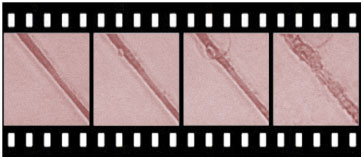| Dec 21, 2011 |
Monitoring the transformation of silver nanowires into gold nanotubes with in situ transmission X-ray microscopy
|
|
(Nanowerk News) A technique for real-time monitoring of the galvanic replacement reaction between silver nanowires and aqueous gold salt solutions using in situ flow-cell transmission X-ray microscopy (TXM) has been developed by scientists in the Center for Nanoscale Materials Nanophotonics Group and the Advanced Photon Source (APS) X-Ray Science Division. Glimpses of the morphological evolution of solid silver nanowires into hollow gold nanotubes are available for the first time by using this technique.
|
 |
| A series of transmission X-ray microscopy images obtained at different times in the course of the galvanic replacement reaction between a silver nanowire and an aqueous solution of HAuCl4, showing the morphological transformation of the solid nanowire into a hollow nanotube. Experiments were performed at the APS 32-ID-C beamline.
|
|
Galvanic replacement reactions between solid metal nanoparticles with oxidizing metal precursors represent a versatile strategy for synthesizing hollow metal nanostructures with tailored properties that are difficult (or even impossible) to achieve from their solid counterparts.
|
|
Understanding the mechanism involved in the nanoscale galvanic replacement reactions is critical for developing robust strategies for the controlled synthesis of hollow nanostructures, but direct observation of morphological evolution of the nanoparticles has not been realized because of the lack of in situ imaging techniques that are compatible with solution-based reactions. By taking the advantage of strong penetration of synchrotron hard X-rays in liquid solutions, in situ TXM in combination with a flow cell enables the real-time monitoring of the reaction between silver nanowires and HAuCl4.
|
|
The work is significant because a multiple-step morphological evolution process has been clearly revealed and the promise of in situ TXM in nanomaterials research has been demonstrated.
|

